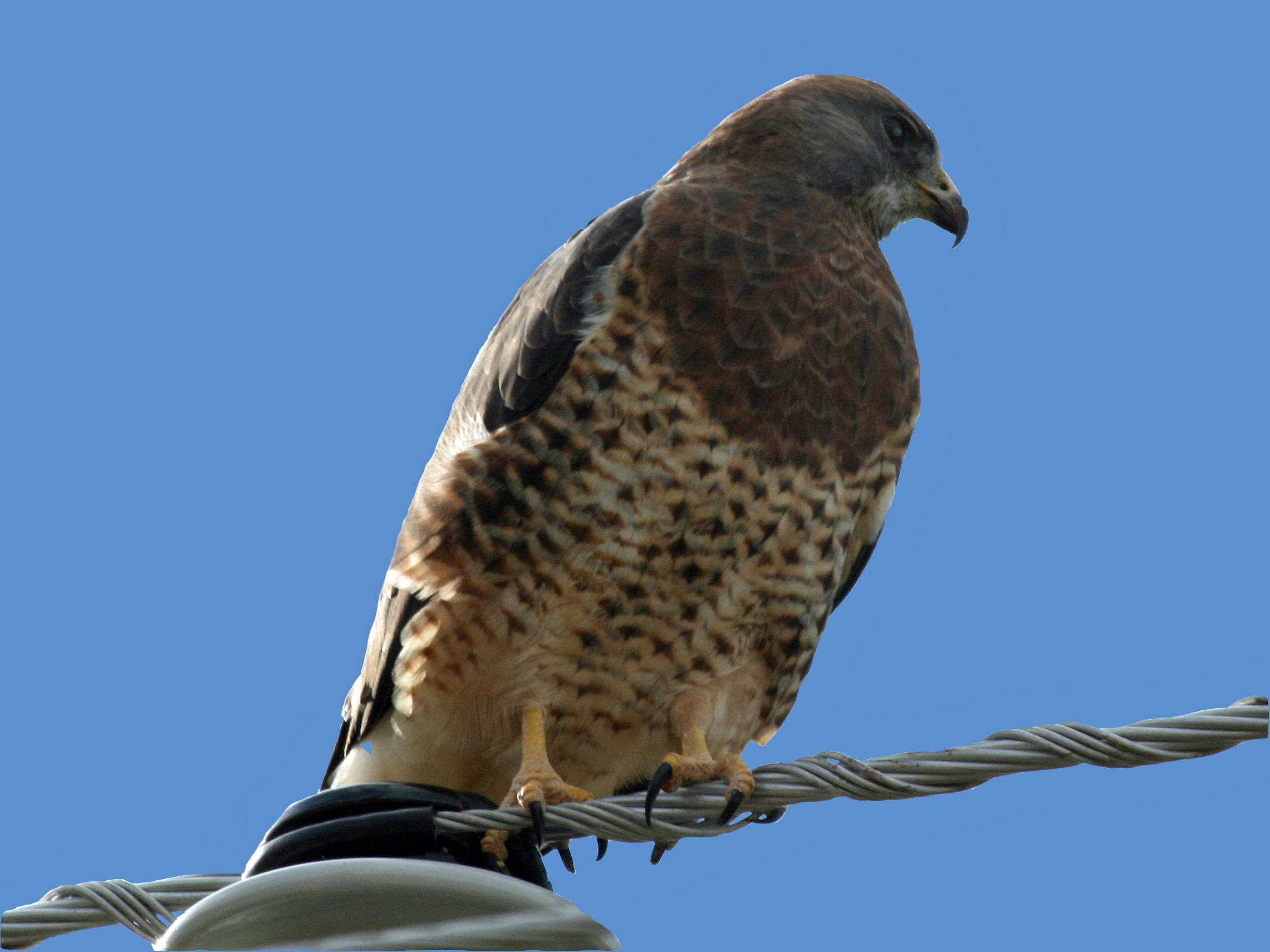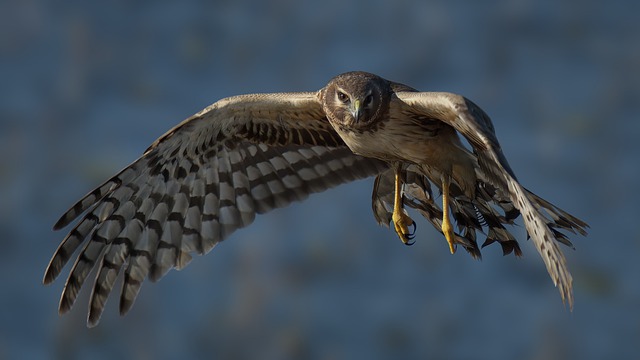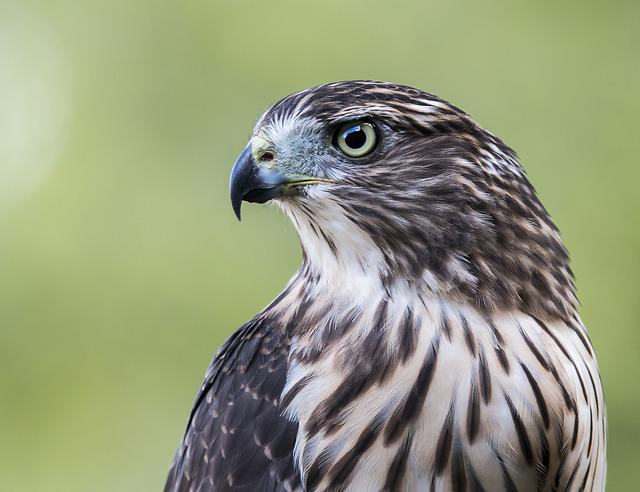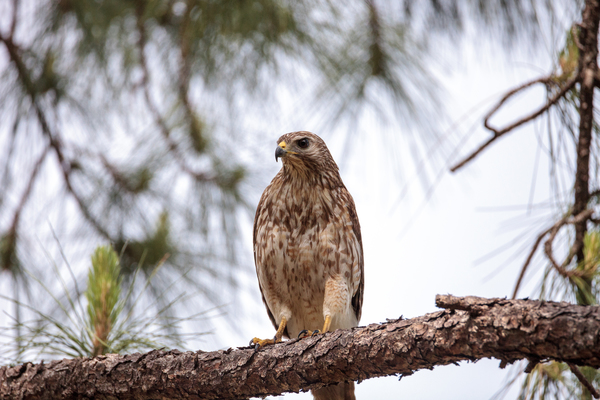There might be up to 25 distinct species of hawks throughout the United States. Because various states have distinct temperatures and food supplies.
Each state does have its own variety of hawks that dwell there at different times of each year.
We’ll talk about hawks in Ohio in this piece. The number of species found in the state, along with a brief overview of each.
Let’s get to know these hawk types from Ohio. I’ll explain each and give a sense of how they appear so that you can recognize them.
| Image | Name |
|---|---|
 | Swainson's Hawk |
 | Northern Harrier |
 | Rough-Legged Hawk |
 | Northern Goshawk |
 | Broad-Winged Hawk |
 | Cooper’s Hawk |
 | Sharp-Shinned Hawk |
 | Red-Shouldered Hawk |
 | Red-Tailed Hawk |
Different Species of Hawks in Ohio
1. Swainson’s Hawk

| Scientific Name | Buteo swainsoni |
| Size | 17 – 22 inches |
| Wingspan | 46 – 54 inches |
| Weight | 1.8 pounds to 2.5 pounds |
| Lifespan | 24 years (captivity); 17 years (wild) |
Because of its preference for grasshoppers and locusts, this hawk is also called the grasshopper or locust hawk, after the British scientist William Swainson.
In Ohio, Swainson’s hawks are uncommon. The majority of populations breed in the continent’s central and western regions and migrate to South America during the winter.
A Swainson’s hawk is occasionally seen in the eastern states.
Habitat
They may be found in open areas like meadows, deserts, and prairies. They usually build their nests on isolated trees towards the canopy.
However, they can also build their nests amid shrubs and bushes or even on the land near the river banks or cliff ledges. Flimsy nests are made from grasses, twigs, and other plant materials.
White underparts and brown upperparts with a reddish chest band, white neck, and facial patches distinguish Swainson’s hawks. Their underwings, which have black flying feathers and white inner wings, help to identify them in flight. Grey-brown bands go along the tail. In the far west of its habitat, a darker variant exists.
Swainson’s hawks feed mostly on insects. They eat insects belonging to the Acrididae family (locusts and grasshoppers). However, depending on the season, they consume crickets and other insects. Small animals, amphibians, birds, and reptiles are preyed upon by breeding birds.
Due to habitat loss, indirect chemical poisoning, as well as other inappropriate agricultural practices, Swainson’s hawk populations have plummeted.
The Galapagos hawk is closely related to this species, and the two have a common ancestor. If you get a chance to spot this hawk in Ohio, it will most likely be scavenging for insects on the ground.
2. Northern Harrier

| Scientific name | Circus hudsonius |
| Size | 16 – 20 inches |
| Wingspan | 38 – 48 inches |
| Weight | 12 to 19 ounce |
| Lifespan | 16 years |
Harriers belong to the Circinae subfamily of hawks. The northern harrier is North America’s sole harrier species. It’s a huge, thin hawk with long wings and a long tail, which harriers are known for.
Female northern harriers have dark brown upper parts, while males have dark grey upper parts. Both are white below and have a distinctive white rump band that is visible when they are flying.
Northern Harriers are migratory birds that nest in the far north of the continent and move south during winter. Grasslands, farms, prairies, and marshes are among their favorite locations. They build their nests amid thick foliage on the ground. They roost in tiny groups during the winter.
Northern harriers are polygynous, unlike most hawks and other raptors. During the mating season, males interact with numerous females.
Harriers hunt by flying low over wide areas and searching the ground for prey. As it hovers near the ground, its large wings form a shallow V-shape. Northern harriers eat small animals and, on rare occasions, birds. Amphibians, reptiles, and insects are used to augment their diet.
The best opportunity of seeing a harrier in Ohio is in the northeast. However, they can be seen around the western shores of Lake Erie as well. They can be seen on the ground, flying low, or perched on low perches.
3. Rough-Legged Hawk

| Scientific Name | Buteo lagopus |
| Size | 18 – 24 inches |
| Wingspan | 47 to 60 inches |
| Weight | 1.3 to 3.7 pounds |
| Lifespan | 18 years (maximum); 2 years (average) |
It’s a huge brown hawk with speckled plumage contrasting with its brown coloring. Wide, white tail feathers having brown bands at the edge distinguish Rough-legged hawks.
They resemble the red-tailed hawk, ferruginous hawk, and common buzzard in appearance.
Rough-legged hawks, sometimes called rough-legged buzzards, are so named because of the feathering on their legs which extends all the way down to their feet, leaving them a rough look.
As they nest in the arctic and move to the south during winter, the feathers on their legs keep them warm. Deserts, prairies, and farmland are their preferred habitats.
Rough-legged hawks make their nests consisting of feathers, sedges, twigs, and some other soft materials on cliff ledges and rocky outcrops.
Rough-legged hawks frequently make their nests near those of peregrine falcons, ostensibly for safety but also because peregrine nests attract a lot of rats and mice.
Rough-legged hawks eat rodents, birds, and small animals primarily. They also consume insects and carrion. They frequently steal other birds’ prey.
They hunt from a perch or while hovering or soaring in the air.
They are often spotted in wide areas. They’ve been seen floating over the terrain, which is unusual for a raptor of their size.
4. Northern Goshawk

| Scientific name | Accipiter gentilis |
| Size | 18 to 27 inches |
| Weight | 0.8 to 4.9 pounds |
| Wingspan | 35 to 50 inches |
| Lifespan | 27 years (captivity); 11 years (wild) |
This is a well-known and widely distributed hawk. The northern goshawk is the largest species in the Accipiter genus.
It has a short tail, long wings, a big beak, and short, stocky legs. Above-ground feathers are blue-grey to brownish-grey in color. Its underparts are light grey to white with brown stripes.
Habitat
They prefer extensive coniferous tracts in other regions of their territory. They prefer deciduous hardwood forests in Ohio.
Northern goshawks construct their nests in the tree tops of the dominant tree species in a particular region. They make enormous stick nests, but they may also take up residence in the nests of many other birds like crows or ravens.
Northern goshawks pair about 500 times per clutch throughout the mating season. Throughout the period, the male does this about twelve times every day to ensure that the offspring are his own.
Northern goshawks are fearsome predators who feed on large birds and small to medium-sized animals. To hunt and ambush prey, they often employ a mix of speed, flexibility, and concealment.
These huge hawks have a diverse diet that includes up to 500 different species. Rabbits, squirrels, and hares are typical mammalian prey. Pigeons, corvids, and game birds are one of their favorite avian prey.
Northern goshawks are divided into eleven subspecies. This is a hardy species with a consistent population. Deforestation is considered to be the greatest danger to northern goshawks.
Because they are typically found high in the canopy, northern goshawks might be difficult to notice. They can be found in big hardwood forests. Please remember that the northern goshawk is among the most aggressive and territorial raptors in the United States.
Humans who approach their nests too closely have been found to be attacked.
5. Broad-Winged Hawk

| Scientific Name | Buteo platypterus |
| Size | 13 to 17 inches |
| Wingspan | 29 to 39 inches |
| Weight | 9.3 to 19.8 ounces |
| Lifespan | 12 years (average) |
As the name implies, it is a tiny to medium-sized hawk having short, wide wings. Its wings have a unique tapering aspect that is not seen in other hawks.
The broad-winged hawk has a dark brown upper surface and a white underside with brown striping. The species comes in two color variations. The lighter variant has much more white in its plumage than the dark form, primarily brown.
Broad-winged hawks nest in the northeastern United States and fly south to Brazil and Mexico during winter. They build their nests in marshes, rivers, and open areas in woodlands.
They frequently make their nests made of sticks and twigs at the woodland border in deciduous trees.
Food
Small animals, particularly rodents like shrews, voles, and chipmunks, are prey for broad-winged hawks. Amphibians, reptiles, and even nesting cardinals, and other tiny birds are all prey for them. They may also eat insects and crabs throughout the winter.
Before soaring quickly at their prey, broad-winged hawks keep a close eye on it from low, hidden branches. They usually start by skinning and plucking their prey, which includes amphibians and birds.
Broad-winged hawk numbers are diminishing in certain areas due to the loss and disruption of their prized forest habitats.
During the mating season, which runs from April through August, they may be seen in Ohio’s woodlands. Listen for their high-pitched whistle cry, which may be heard from high in the canopy.
6. Cooper’s Hawk

| Scientific Name | Accipiter cooperii |
| Size | 14 to 20 inches |
| Weight | 11.9 to 1.248 pounds |
| Wingspan | 24 to 39 inches |
This medium-sized hawk belongs to the Accipiter genus and is titled after naturalist William Cooper.
They are sometimes mistaken for the northern goshawk and the sharp-shinned hawk, which are both identical but smaller.
Habitat
Cooper’s hawks may be found in a variety of environments, including deciduous, coniferous, and mixed forests, as well as woods, farmlands, and floodplains.
They create huge platform nests up to 50 feet above the ground with forks of giant trees. They cover their nests using bark strips and leaves and make them from sticks and twigs.
Cooper’s hawks have blue-grey to greyish-brown feathers on their heads. They have reddish bars and stripes on the bottom and are cream-white on top.
Their heads are crowned with dark brown feathers, which can make them look squarish when ruffled. They have big toes with strong nails and strong, sturdy legs.
Cooper’s hawk is a fast-flying raptor with a bold, aggressive personality suited to chasing huge, elusive prey. As a result, it’s also known as the striker, the big-blue darter, or the fast hawk.
It surrounds its target in a twisting flight during a hunt, periodically darting from tree to tree before gaining momentum for its assault. Small to medium-sized songbirds and small animals and reptiles are prey for Cooper’s hawks.
Due to competition with people for game birds, this species has been extensively hunted in the past by direct poisoning, shooting, and trapping.
The species grew more timid and elusive as their numbers dropped. Indirect pesticide exposure had a significant influence on them as well.
Because of State protection and the prohibition on DDT insecticides, their population numbers are now steady and growing. Cooper’s hawks can be found in forested regions throughout the state.
7. Sharp-Shinned Hawk

| Scientific Name | Accipiter Striatus |
| Weight | 2.9 to 7.7 ounces |
| Wingspan | 17 to 27 inches |
| Size | 9.1 to 15 inches |
The sharp-shinned hawk is North America’s tiniest hawk, with males measuring as tiny as nine inches in length. Sharp-shinned hawks are distinguished by their large wings and long, thin golden legs. Sub-species have different plumage.
Sharp-shinned hawks in Ohio are classified as nominate group A. s. striatus. They have tawny legs and are blue-grey above and striped white underside.
Their eyeballs are orange-red, as well as their cheeks are rufous.
This little hawk may be found in woods and forests. Sharp-shinned hawks build stick nests in deep forests, usually in huge conifers or deciduous trees.
Food
Sharp-shinned hawks eat sparrows, warblers, and tits, among other tiny birds. To catch their prey, they exploit the element of surprise.
These little hawks are quick raptors, capable of negotiating deep thickets and stalking their prey while hidden by cover.
Pesticide poisoning caused dramatic losses in the species in the past. However, populations have thrived after DDT was banned.
Migrating birds might be seen in flight or in open areas.
Sharp-shinned hawks have been observed preying on gardening birds at bird feeders.
8. Red-Shouldered Hawk

| Scientific Name | Buteo lineatus |
| Wingspan | 35 to 50 inches |
| Weight | 1.2 to 1.5 pounds |
| Size | 15 to 24 inches |
The red-shouldered hawk is a beautiful woodland raptor. The barred, warm crimson of the chest and chest contrasts starkly with the dark-brown and white speckled upper wings and back.
They have a large tail and long golden legs.
When perched, the hawk’s trademark crimson shoulders are evident. However, the white patches on its back are much more noticeable.
Despite this, they are frequently mistaken for the bigger red-tailed hawks.
Woodlands and low-lying hardwood woods near rivers and deciduous marshes are home to red-shouldered hawks. Unfortunately, most of their habitat has been disrupted by deforestation, which has negatively influenced the species.
They are, nevertheless, flexible, and if evicted, they may seek refuge in forests near human settlements and suburban areas.
Red-shouldered hawks have resident populations in Ohio, as well as migratory birds coming from the northeast. Stick nests are built by breeding couples in the major forks of big trees.
Shredded leaves, bark, and sprigs are used to line their nests.
Food
Rodents are the main food source for red-shouldered hawks. They hunt from a perch or while flying, striking prey from a great distance.
Some of their favorite prey are moles, gophers, voles, and chipmunks. Amphibiansbirds, crabs, fish, reptiles, and huge insects are also among their prey.
Red-shouldered hawks can take down larger prey. Squirrels, rabbits, and medium-sized birds like pheasants and jays have all been known to fall prey to them. During the winter, they frequently prey on garden birds at bird feeders.
The broad-winged and red-shouldered hawks’ calls may be imitated by blue jays. It’s unknown whether they do this to avoid predators.
In Ohio, red-shouldered hawks can be spotted in deciduous woods near waterways and marshes, as well as in residential gardens and woods.
9. Red-Tailed Hawk

| Scientific name | Buteo jamaicensis |
| Wingspan | 3 ft 5 inches to 4 ft 10 inches |
| Size | 18 to 26 inches |
| Weight | 1.5 to 3.8 pounds |
| Lifespan | 29 years (captivity); 25 years (wild) |
The red-tailed hawk is by far the most common and widely distributed hawk species in North America. This adaptable raptor’s capacity to adapt to a variety of settings is what keeps it so successful.
Habitat
They like open areas and may be found in grasslands, croplands, and open woodlands. They have, however, been known to venture outside their natural environment, into sandy deserts, deep woods, and even metropolitan areas.
After the ferruginous hawk, this is the second-biggest Buteo hawk in North America, and they are one of Ohio’s biggest raptors.
The rusty red on the top side of the tail gives the subspecies its name. Aside from this distinguishing trait, red-tailed hawks have a wide range of plumage. There are 14 different subspecies, each with its own color and region of occurrence.
Red-tailed hawks are incredibly adaptive with their nutrition, just as they are with their habitats. They are opportunist hunters that eat a variety of food, including mammals and rodents, as well as birds, reptiles, amphibians, and invertebrates.
They normally hunt by swooping down on their prey from a high perch. The feet of red tails are huge and robust, with long nails. They are skilled predators who can adapt their tactics and strategies to their prey and environment.
Red-tailed hawks build their nests in the canopy of towering trees that can reach 70 feet in height. Human-made structures like power-line poles, towers, and high-rise skyscrapers are also used.
The nest is built of twigs and sticks, including pine needles, pieces of bark, and other greenery lining the interior.
Some Native American tribes regard the red-tailed hawk’s plumage to be holy and employ them in religious rites.
The most prevalent falconry hawk breed in the United States is the red-tailed hawk.
If interested then check this article on Types of Woodpeckers in Ohio.
Conclusion
Hawks have piqued the attention and awe of mankind since the dawn of humanity. They are incredibly clever beings.
Hawks are one of the most intellectual birds, as per a comprehensive avian IQ measure.
They are easy to train as a result and have been employed in falconry for generations.
Hawking or Falconry was the old name for the sport.
FAQ
Is It Allowed In Ohio To Kill A Red-Tailed Hawk?
It is illegal to kill or injure hawks in any manner. If Wildlife Services has made your land into a regular spot for easy capture, you can get a permit from them.
Last Updated on March 22, 2023 by Lily Aldrin
